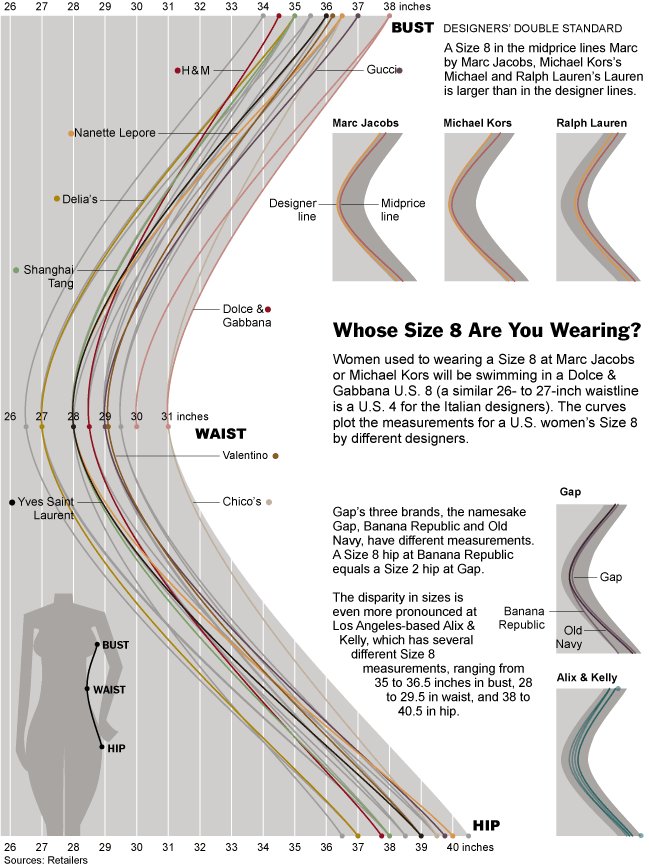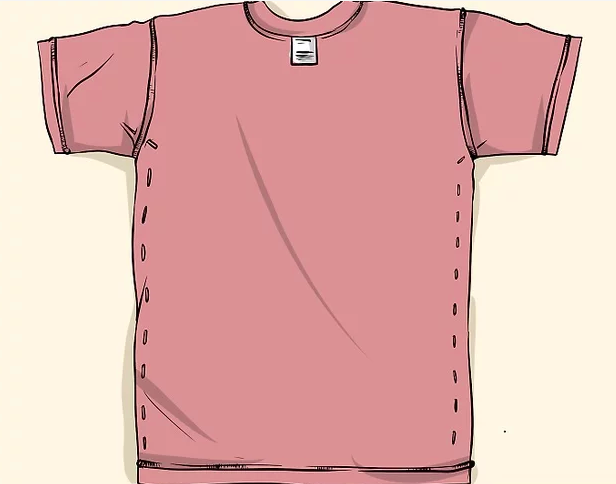Tips for Altering Your Clothes: Where to Start and Why
Who knew that with right tips for altering your clothes, you could be looking at a whole different wardrobe? Last week, during my Wine Wednesday Style Chat, I asked for topic ideas. And there were a few of you who requested covering the topic of alterations and tailoring. And you know what? The topic of alterations is such an IMPORTANT one! So today, I'm doing a deep dive into why it's important to tailor your clothes. And I'm also sharing a FREE downloadable PDF filled with tips for altering your clothes.
[show_shopthepost_widget id="3674834"]
Tips for Altering Your Clothes to Improve Your Wardrobe
First off, understand that there exists such a thing as standardized sizing and vanity sizing. Clothing doesn't fit our individual bodies in the perfect way. Clothing is mass created for the 'standard' body size, which is why sizing varies widely.
vanity sizing chart via the new york times
As Julia Felsenthal detailed over at Slate, today's women's clothing sizes have their roots in a depression-era government project to define the "Average American Woman" by sending a pair of statisticians to survey and measure nearly 15,000 women. They "hoped to determine whether any proportional relationships existed among measurements that could be broadly applied to create a simple, standardized system of sizing," Felsenthal writes.
Sadly, they failed. Not surprisingly, women's bodies defied standardization. The project did yield one lasting contribution to women's clothing: The statisticians were the first to propose the notion of arbitrary numerical sizes that weren't based on any specific measurement — similar to shoe sizes.
-Article, The Absurdity of Women's Clothing Sizes, by Christopher Ingraham of the Washington Post
This is where the importance of a tailor comes in. If you expect to look great in clothing, then expect to spend money on tailoring.
Which Alterations are Worth the Money?
Not every single alteration is going to suddenly make your clothing awesomely amazing if there were thirty things you didn't like about the piece to begin with. You need to make sure that you love the color, pattern, print, and fabric first. If you do, then there are some minor tweaks that will make it simply perfect for you. Here are a few tips for altering your clothes in the right way. These alterations are the easiest to have done to a garment and won't have you spending a fortune.
Shortening or Lengthening a hem
Taking in a shirt or pants on the sides
Adding darts (folds) to have a top or bottom fit more smoothly around your body
pieces made from cotton and linen
Average Pricing for Alterations
The average price of alterations is between $12.00-$40.00. Any garment or article of clothing that has more detail to it will be more expensive to alter. Here is a quick overview of what to expect to pay at any given tailor or alterations shop:
shortening a hem - $12-$20 (with lining, add $5)
taking in pants - $18-$22 (add $5 with lining)
adding darts - $12-$25
replacing a zipper - $8.00-$12.00
adjusting a waistband - $12.00
What Makes Alterations more Expensive?
Leather
embroidery
zippers
moving pockets
clothing with interior lining
pleats
lace, fringe, feathers, etc.
alterations near multiple seams (shoulders...)
fabric type: chiffon, silk, jersey, and organza are costly
Tips for Where to Alter What
Golden Rule (Alison Freer): Anywhere a straight seam exists is fair game for an alteration. (ie: sides, bottom). But anywhere near an underarm, inseam, or shoulder makes it a bit more complicated to alter.
Shirts/Jackets - DOs
Hem Length: Alter your shirts so they graze just below the widest part of your hips.
Take in the Sides: Make sure you have enough room in the underarm if you take in the sides. If it's tight in the underarms, but big on the sides, it's not worth it.
Raise Straps: Shortening straps on tanks or taking up blouses with thin straps that fit too low will improve the look of the shirts.
Slim down a very loose sleeve
Shirts/Jackets - Avoid
Any shirt, top, or blouse that fits poorly at the shoulders (seam extends too far out past your natural shoulder or doesn't meet the line of your natural shoulder) is not worth a fix. The shoulders on a jacket or blazer should hit right at the physical shoulder of your body. If it's too tight, your bicep will bulge slightly in the arm.
Trying to have something too small let out
Pants/Jeans - DOs
Hem the length! The length is a personal preference but a rule of thumb is to hem the pant so the bottom falls in a straight line from waist to ankle or mid-shoe. Bring shoes with you to try at the tailor.
Taper a pant leg so it wears in a sleek, slim line along your leg. No bunching at the bottom or dragging on the ground! A tailor can cut away the excess fabric from the waistband to the low hip if they are too wide in the hips.
What Isn't Worth Taking to the Tailor
I imagine that most of us have pieces we look at and wonder, "Is it worth altering?" Well, here are some reasons why you should avoid taking something to the tailor.
Armhole doesn't fit right - this is the key to a garment and if it doesn't look right because it's puckering or poor fitting, a tailor won't be able to fix it.
A garment is too tight, small, or snug - letting out a seam is often costly and there isn't enough fabric to do it properly, so just avoid it all together and let go of the item.
Very intricate, detailed garments (see section on What Makes Alterations more expensive)
Finding the Right Tailor
Starting with your dry cleaner is a great place to begin. Most dry cleaners have an alterations person on staff or are trained themselves in tailoring. Or source Yelp for a good alterations specialist. I also use Nordstrom and Madewell's alterations department whenever I buy a pair of denim. As Kendall Farr put it in her book, The Pocket Stylist, a good tailor is like a good hairstylist: a professional who understands when to trim away a little and how to change the shape altogether.
[show_shopthepost_widget id="3674834"]





